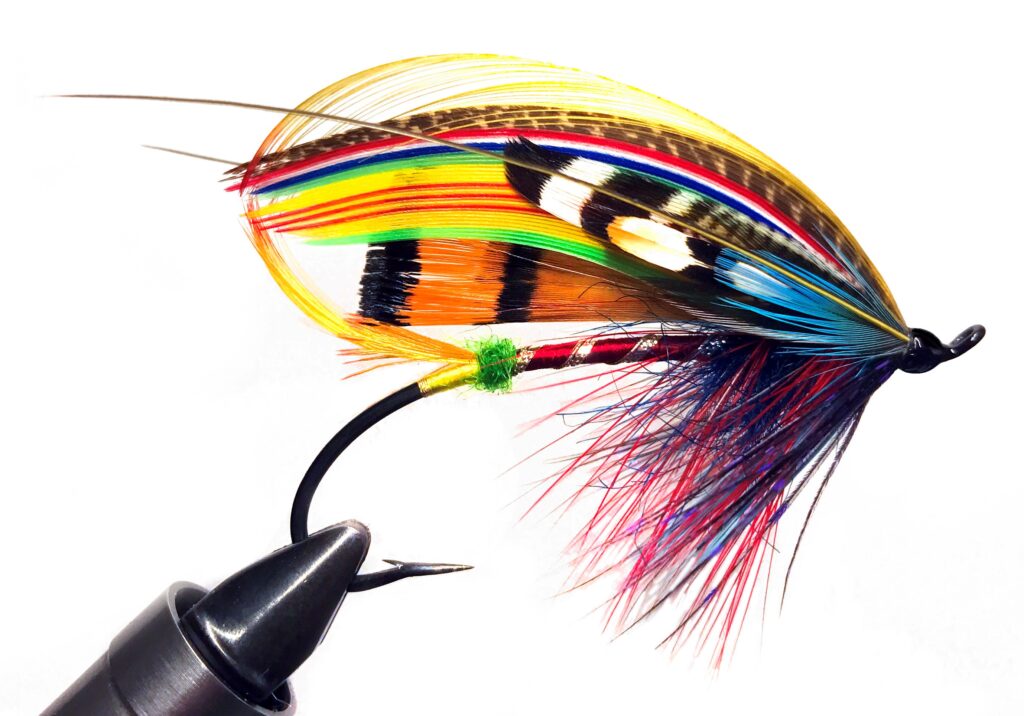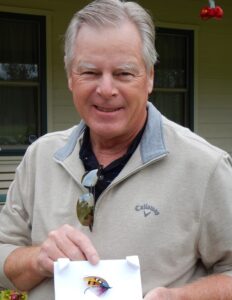NEWS & STORIES
“The Captain Nicholson” by John Van Derhoof
Because of the significance of the retirement of Ed Nicholson as President of PHWFF and his last Board of Trustees meeting on March 30, 2017, it was imperative that a very special commemoration be planned. Having been associated with PHWFF in a variety of ways since 2007, John Van Derhoof agreed to design and create a fly to honor Ed. It was presented to Ed in a shadow box at the March 30 meeting.
Founder Ed Nicholson named President Emeritus of Project Healing Waters Fly Fishing

The inspiration for the fly was to utilize the Vietnam service ribbon as the foundation while adding elements of the American flag in tribute to Ed’s service both while in the military and for his support of the thousands of lives he has so wonderfully affected through Project Healing Waters Fly Fishing. As this was the first salmon fly I had tied in a very, very long time I wanted to tie something significant for Ed but not too horribly taxing for me. Difficult yes, both not over the top. For this occasion I wanted to stay with a traditional salmon fly appearance, such as the Mixed Wing style that was finally adopted, in lieu of some of the more impressionistic and stylized flies I tied 25 years ago.
I began the process by doing a rough drawing in colored pencil and then in Photoshop to see how the color combinations of the wing looked and how it could be paired with the rest of the fly. I also used these drawings to insure a harmony between the primary colors of the service ribbon (green, gold and red) with the red, white and blue of the American flag that would come to dominate the body color. While the colors and patterns used are fairly obvious, others, like a dash of purple at the throat to signify the Purple Heart, are a bit more obtuse reference.
I started tying the fly first preparing the wings. Once the wing segments were married I get could determine the final proportions of the fly. You should note that when this fly is stood on its nose (the eye of the hook) that the size and shape of the wing matches the size and shape of the hook forming a heart. My style of tying Atlantic salmon flies is to not tie a streamer but to use the hook shape as an integral and balanced component of the completed fly.
I have added the materials used to tie this fly and I sincerely hope that every time Ed looks at this he can be proudly reminded of all of the lives he has enriched.
Tag: Extra fine round 14kt. gold tinsel and golden yellow silk floss.
Tail & Veiling: Golden Pheasant crest with Indian Crow veiling about ½ the length of the tail
Butt: Highlander green seal fur
Body: Rear – 2/3 crimson silk floss
Front – 1/3 navy blue seal fur
Ribbing – Sterling silver embossed tinsel followed by 14kt. Fine round gold tinsel
Hackle: Body – Crimson rooster
Throat – Kingfisher blue rooster with purple guinea fowl in front
Underwing: Golden Pheasant Tippet
Wing: Turkey from bottom to top – 3 strands Highlander green; 5 strands of golden yellow; 1 strand each red, yellow, red, yellow, red; 5 strands of golden yellow; 3 strands Highlander green; 3 strands of navy blue; 2 strands of white; 3 strands of crimson; capped with 5 strands of Kori Bustard.
Sides: Wood duck flank feather followed by Jungle Cock and Kingfisher
Topping: Golden Pheasant crest
Horns: Blue/Yellow Macaw
Note: All materials are the actual feathers or hair/fur as listed above with the exception of the Indian Crow tail veiling. It was custom dyed by Eric Otzinger and is as close to the original as one could hope to get.
About John Van Derhoof:
 John Van Derhoof was the recipient of the International Federation of Fly Fishers’ highest honor for fly tiers, the Bus Buszek Memorial Award, at the 2007 National Conclave (now called the Fair). This award is presented annually to the individual who has made significant contributions to the art of fly tying, and recognizes tying skill, innovation, and sharing knowledge by teaching or publication.
John Van Derhoof was the recipient of the International Federation of Fly Fishers’ highest honor for fly tiers, the Bus Buszek Memorial Award, at the 2007 National Conclave (now called the Fair). This award is presented annually to the individual who has made significant contributions to the art of fly tying, and recognizes tying skill, innovation, and sharing knowledge by teaching or publication.
John has been tying flies for 54 years. As an innovative and extraordinary fly tier, for the last 35 years John has demonstrated, taught and written about tying all over the United States. For the same 35 years, he has distinguished himself as an expert fly casting instructor, and has served on several IFFF national boards and committees. He is in demand as a tier, caster, rod builder, artist and personable walking encyclopedia of everything related to fly fishing.
He began tying salmon flies in earnest in 1979 and first tied as a demonstrator at the local Southwest Council of the Federation of Fly Fishers Conclave in 1981. John did demonstration tying at every IFFF National Conclave from 1984 until 1992. From 1984 to1987, John taught the Atlantic Salmon Fly Class at the FFF Conclave. Several of John’s students have won the Buszek Award: Boyd Aigner (‘80), Billy Munn (‘86), Dick Nelson (‘87), Jimmy Nix (‘89), Royce Dam (‘94), Marvin Nolte (‘95), Judy Lehmberg (‘97), and Bill Heckel (‘03). Of the 28 Buszek Awards winners 1980-2007, eight or 29% have been John’s students.
John has taught and/or demonstrated fly tying at approximately 70 regional conclaves and a variety of fly fishing shows all over the US. He has done demonstration tying at every Southwest Council of the IFFF Regional Conclave, and won the IFFF Southwest Council Fly Tier of the Year Award in 1992, the only recipient of that award. John is a member of Phrozen Phantom Phlytier, a who’s who in fly tying and fishing, the membership of which includes Lefty Kreh, Gary LaFontaine, Darwin Atkin, Craig Matthews, etc.
An indication of the desirability of his flies is that eleven plates of 1–3 flies have sold for over $1000 each. One of his plates with a single fly sold for $1700. John was one of five local salmon fly tiers who each tied a Jock Scott fly for a plate that sold for $2400 at auction, and one of his salmon flies was traded for a $2000 bamboo rod. He was one of the twelve tiers featured in a Phrozen Phantom Phlytier plate that netted over $3000 and which now hangs in the IFFF Museum.
John was a tying contributor to Stephen J. Meyers’ Streamside Reflections, published in 1990. He was one of sixteen American tiers of salmon flies featured in Judith Dunham’s book, The Atlantic Salmon Fly, published in 1991; his flies were in an exhibit at the Museum of Art of the University of California at Northridge in 1992 as a result of this book. John and his flies have been mentioned in books by Gary LaFontaine, Lefty Kreh, John Randolph and several others, as well as in Fly Fisherman and American Fly Tier magazines. Every month since September, 1997, John has illustrated and written the popular “Fly of the Month” articles for Long Beach Casting Club’s Target Talk newsletter.
Some of the effective flies he has developed for salt, steelhead, bass and trout fishing include the Halo, Upright BWO, Hank o’ CDC, Bend-Back Sculpin, Looped-Wing Emerger, Bullethead Cicada, Anchovy-Baitfish and John’s Sliders for steelhead and trout. Gary LaFontaine loved John’s Trout Slider and, in one of his books, described it as one of his favorite waking/attractor patterns. John’s “novelty” flies were realistic flies tied in the style of Poul Jorgenson with salmon fly materials and married wings, such as a full dressed Jock Scott on a 5/0 hook with an extended body for Bing Lempke, the 1988 Buszek Award recipient and noted extended body fly tier. Other truly realistic flies using married wings with legs, antennae, eyes, etc., were tied on salmon hooks with salmon materials and included stoneflies, mayflies with extended bodies, caddis flies, damsel and dragonflies.
John’s accomplishments extend beyond fly tying. He started working with Les Eichhorn of Sage in 1983 and taught Sage Casting Schools all over Southern California, Alaska, Montana, Arizona and Nevada. He continued to teach these classes with Les, Lani Waller or by himself until 1991. He taught Sage Fly Fishing Schools in Alaska and Mexico with Lani Waller.
John was named to the IFFF Casting Instructor Certification Advisory Committee at its inception in 1992 and received his Master Casting Instructor Certification in 1997. The 2-handed instructor certification followed in 2009. John is the only person in the world who is a Master Certified Casting Instructor, 2-Handed Certified Instructor and a Buszek Award Winner. He was elected to the IFFF Casting Instructor Certification Board of Governors in 1999, a position he held until he retired in 2006.
An artist of considerable repute, John prepared the design and artwork for the pin that the IFFF Lifetime Achievement in Fly Casting Instruction Award recipients receive. John also designed the IFFF Casting Instructor Certification Decal, Southwest Council IFFF logo and the American Casting Association logo. John is known as an accomplished rod maker, having built more than 100 sought-after rods. He has won awards for both distance and accuracy casting, teaching fly casting, and served as president of Long Beach Casting Club 1982-83.
I personally have never understood how John has had the time to do all that he has, work full time as a landscape architect, have a lovely family, and still remain the amazing person that he is. Some of us mere mortals would need several lifetimes to accomplish what John has so far in his. He is a great fisherman, long-time supporter of PHWFF and great friend to many of us.